
Bobsleigh or bobsled is a winter sport in which teams of 2 to 4 athletes make timed runs down narrow, twisting, banked, iced tracks in a gravity-powered sleigh. International bobsleigh competitions are governed by the International Bobsleigh and Skeleton Federation.

Skeleton is a winter sliding sport in which a person rides a small sled, known as a skeleton bobsled, down a frozen track while lying face down and head-first. The sport and the sled may have been named from the bony appearance of the sled.
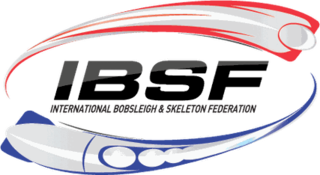
The International Bobsleigh and Skeleton Federation (IBSF) is the international sports federation for the sliding sports of Bobsleigh and Skeleton. It was founded on 23 November 1923 by the delegates of Great Britain, France, Switzerland, Canada, and the United States at the meeting of their first International Congress in Paris, France. In June 2015, it announced a name change from FIBT to IBSF. The federation's headquarters are in Lausanne, Switzerland.
Nicola Minichiello is a retired British bobsledder who competed between 2001 and 2011. She won two medals in the two-woman event at the FIBT World Championships, winning a silver in 2005 and making history with a gold in 2009 partnering Gillian Cooke, to become the first British female bobsleigh driver to win a World Championships. Competing in three Winter Olympics, Minichiello earned her best finish of ninth in the two-woman event at Turin in 2006. This was also the best ever Olympic result by a GB women’s bobsleigh team.
The FIBT World Championships 2008 ran February 11–24, 2008 in Altenberg, Germany for the fifth time, having done so in 1991 (bobsleigh), 1994 (skeleton), 1999 (skeleton), and 2000. It is the first time Altenberg has hosted all of those events at one championship, and also includes the mixed team event that debuted at the 2007 championships. Training for the events took place February 12–14 for two-man and two-woman bobsleigh, and February 19–20 for skeleton and four-man bobsleigh.
The FIBT World Championships 2009, officially known as the Bauhaus FIBT Bobsleigh & Skeleton World Championships, February 20 to March 1, 2009, at the bobsleigh, luge, and skeleton track in Lake Placid, New York, for the ninth time, doing so previously in 1949, 1961, 1969, 1973, 1978, 1983, 1997 (skeleton), and 2003. Lake Placid was chosen 25–11 over Igls, Austria.

The Königssee bobsleigh, luge, and skeleton track is a venue in Germany for bobsleigh, luge and skeleton, located in Schönau am Königssee, Bavaria, near Königssee and the border with Austria. Completed 56 years ago in 1968, it is the first permanent, artificially refrigerated bobsleigh, luge, and skeleton track in the world. In July 2021, the track was severely damaged by the floods that affected the European continent, and is currently under reconstruction.
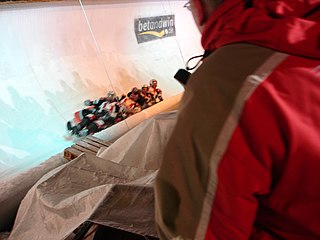
The Olympic Sliding Centre Innsbruck is a venue for bobsleigh, luge and skeleton located in Igls, Austria. The most recent version of the track was completed in 1975 and is the first permanent, combination artificially refrigerated bobsleigh, luge, and skeleton track, serving as a model for other tracks of its kind worldwide. It hosted the bobsleigh, luge, and skeleton competitions for the 2012 Winter Youth Olympics.

The Eugenio Monti Olympic Track was a bobsleigh and skeleton track located in Cortina d'Ampezzo, Italy. It was named after Eugenio Monti (1928–2003), who won six bobsleigh medals at the Winter Olympic Games between 1956 and 1968 and ten medals at the FIBT World Championships between 1957 and 1966. It was featured in the 1981 James Bond film For Your Eyes Only, held after the 1981 FIBT World Championships, before the track was shortened to its current configuration. In January 2008, after one last bobsleigh race tournament, the track was closed.
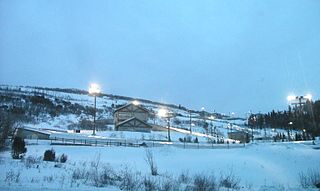
The Utah Olympic Park Track is a bobsleigh, luge, and skeleton track in the United States, located in the Utah Olympic Park near Park City, Utah. During the 2002 Winter Olympics in nearby Salt Lake City, the track hosted the bobsleigh, luge, and skeleton events. Today the track still serves as a training center for Olympic and development level athletes and hosts numerous local and international competitions. It is one of two national tracks; the other is at Mt. Van Hoevenberg near Lake Placid, New York.

The Whistler Sliding Centre is a Canadian bobsleigh, luge, and skeleton track located in Whistler, British Columbia, that is 125 km (78 mi) north of Vancouver. The centre is part of the Whistler Blackcomb resort, which comprises two ski mountains separated by Fitzsimmons Creek. Located on the lowermost slope of the northern mountain, Whistler Sliding Centre hosted the bobsleigh, luge, and skeleton competitions for the 2010 Winter Olympics.

Lillehammer Olympic Bobsleigh and Luge Track is a bobsleigh, luge and skeleton track located at Hunderfossen in Fåberg, Norway, 15 kilometers (9 mi) north of the town center of Lillehammer. It was completed in 1992 for the 1994 Winter Olympics, where it hosted the bobsleigh events and luge events. It has since also hosted the FIBT World Championships 1995 in skeleton and the FIL World Luge Championships 1995, and hosted 2016 Winter Youth Olympics.
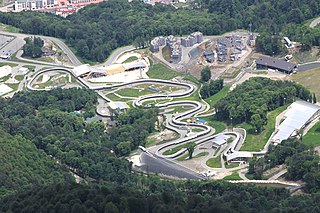
The Sliding Center Sanki (Санки) is a bobsleigh, luge, and skeleton track located in Rzhanaya Polyana, Russia, 60 km (37 mi) northeast of Sochi. Located in the Western Caucasus. The venue hosted the bobsleigh, luge, and skeleton events for the 2014 Winter Olympics.
Robert Hargan Storey is a Canadian bobsledder who competed from the mid-1960s to the early 1970s who later became a businessman and chairman of two communication companies in Canada. Storey served as fourth president of the Fédération Internationale de Bobsleigh et de Tobogganing from 1994 to 2010, and was instrumental in Vancouver being awarded the 2010 Winter Olympics. He went on to marry Catherine Storey and they had three children.
The bobsleigh competition of the Vancouver 2010 Olympics was held at the Whistler Sliding Centre between 20 and 27 February 2010.
The skeleton competition of the Vancouver 2010 Olympics was held at Whistler Sliding Centre. The events were held between the 18 and 19 February 2010. This event was expanded to four runs over two days beginning at these Olympic Games.
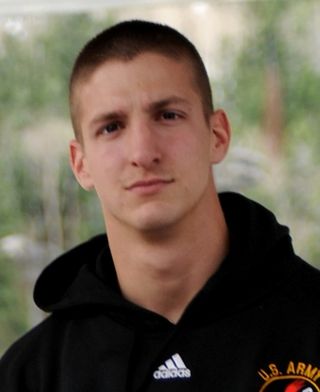
John Napier is an American bobsled driver and a soldier in the U.S. Army World Class Athlete Program. He won the two-man event at the 2009 U.S. National Bobsled Championships with Cory Butner. At the 2009 FIBT World Championships, he placed 17th in the two-man event with T.J. Burns and 11th in the four-man event with Jesse Beckom, Jamie Moriarty, and Nick Cunningham.

The two-man bobsleigh competition at the 2010 Winter Olympics in Vancouver, British Columbia, Canada, was held at the Whistler Sliding Centre in Whistler, British Columbia on 20–21 February. The German team of André Lange and Kevin Kuske were the defending Olympic champions in this event. Switzerland's team of Ivo Rüegg and Cedric Grand were the defending world champions in this event. The test event held at the Olympic venue was won by the German duo of Thomas Florschütz and Marc Kühne. The last World Cup event prior to the 2010 Games took place in Igls, Austria on 23 January 2010 and was won by the Swiss duo of Beat Hefti and Thomas Lamparter while Rüegg won the overall World Cup in the two-man event.

The four-man bobsleigh competition at the 2010 Winter Olympics in Vancouver, British Columbia, Canada, was held at the Whistler Sliding Centre in Whistler, British Columbia, on 26–27 February. The German team of André Lange, René Hoppe, Kevin Kuske, and Martin Putze were the defending Olympic champion in this event. America's team of Steve Holcomb, Justin Olsen, Steve Mesler, and Curtis Tomasevicz were the defending world champions in this event. The test event was won by the Latvian team of Jānis Miņins, Daumants Dreiškens, Oskars Melbardis, and Intars Dambis. The last World Cup event prior to the 2010 Games place took place in Igls, Austria on 24 January 2010 and was won by the German team of Lange, Hoppe, Kuske, and Putze. Holcomb of the United States won both the four-man and the combined World Cups.

The women's skeleton event at the 2010 Winter Olympics took place at the Whistler Sliding Centre on 18–19 February. The competition was won by British athlete Amy Williams, who set new course records for the track on her first and third runs. Williams, who had never before won a World Cup or World Championship event, became the first British athlete to win a solo Winter Olympic gold medal in 30 years. German sliders Kerstin Szymkowiak and Anja Huber won the silver and bronze medals respectively. Williams' teammate Shelley Rudman, who had won the silver medal at the 2006 Winter Olympics, and Canadian Mellisa Hollingsworth, both of whom had been expected to be in medal contention, were disappointed.














